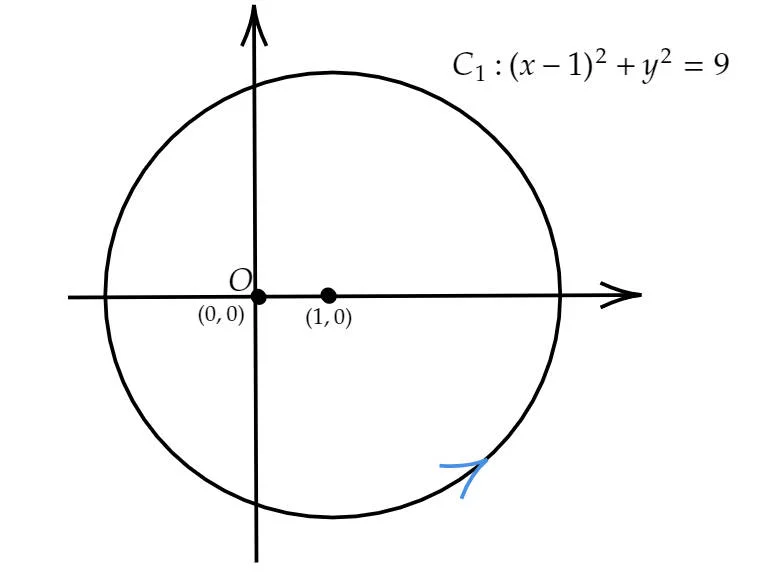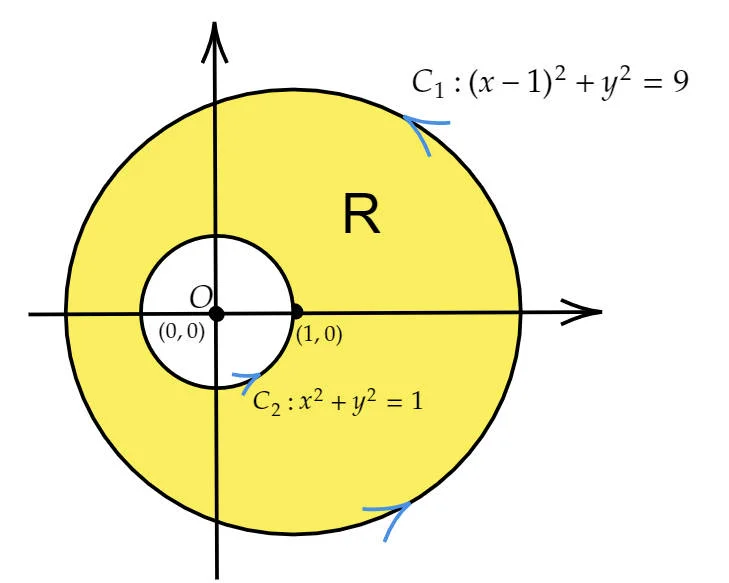Discussion of Green's Theorem (3)

1 Question:
Evaluate
where $C_1$ is the circle $(x-1)^2+y^2=9$, traced in the anti-clockwise direction.
2 Discussion:
Since the curve $C_1$ is given by $(x-1)^2+y^2=9$, then the corresponding domain $D$ enclosed by $C$ is:
which is a disc without any holes.
The corresponding diagram is as below:

Next,
$$ \int_C\frac{xdy-ydx}{\pi(x^2+y^2)}=\frac{1}{\pi}\int_C \begin{pmatrix} \frac{-y}{x^2+y^2}\\ \frac{xdy}{x^2+y^2} \end{pmatrix} \cdot \begin{pmatrix} dx\\ dy \end{pmatrix} =\frac{1}{\pi}\int_C F \cdot dr, $$where $F=\begin{pmatrix}\frac{-y}{x^2+y^2}\\ \frac{x}{x^2+y^2}\end{pmatrix}=\begin{pmatrix}P\\ Q\end{pmatrix}$, $dr=\begin{pmatrix} dx\ dy\end{pmatrix}$, and $r=r(t)$ is the parametric equation of the curve $C$.
Note that $F$ is undefined at $(x,y)=(0,0)$.
2.1 Idea 1:
Recall, for a vector field $F$, the line integral of $F$ along $C$ is
For this problem, $r(t)=\begin{pmatrix}1+3\cos t\\ 3\sin t\end{pmatrix}, 0 \leq t \leq 2\pi$, and hence,
Theoretically, this method should work,but in practice,as you see the above definite integral is too complicated to handle, so let’s try to figure out some other ideas.
2.2 Idea 2:
Assume $ F=\begin{pmatrix}P\\ Q\end{pmatrix}$. We know $F$ is undefined at $O(0,0)$, and then it’s easy to check $P_y=Q_x$ when $(x,y)$ is on the domain $D$ except the origin $O(0,0)$.
Thus, by the test for the conservative vector field, $F$ is conservative on $D$ except $(0,0)$, NOT on the whole region $D$ or for the each point of region $D$.
Hence, Fundamental Theorem of Line integrals is NOT applicable here, which is, we can not perform
2.3 Idea 3:
As $F$ is undefined at $O(0,0)$,the actual domain of integration in this problem should be
which is a disc with a hole,and we call it non-closed. Hence, Green’s Theorem can NOT be applied directly in this case. So what else shall we do? We can draw a unit circle, $i.e. C_2:x^2+y^2=1$ , where the little hole $O(0,0)$ is within this circle, as shown in the following diagram:

Where R is is the region between $C_1$ and $C_2$, and the boundary of $R$ is $\partial R=C_1-C_2$
By the Green’s Theorem,
as $P_y=Q_x$ is conservative on the region $R$.
$\implies \int_{C_1-C_2} F \cdot dr =0$, $\implies \int_{C_1}F \cdot dr =\int_{C_2}F \cdot dr=2$,based on the result obtained in the last post,say the Discussion of Green’s Theorem (2).
3 Credit:
The question is from Dr. Tuan Seng Chew.




